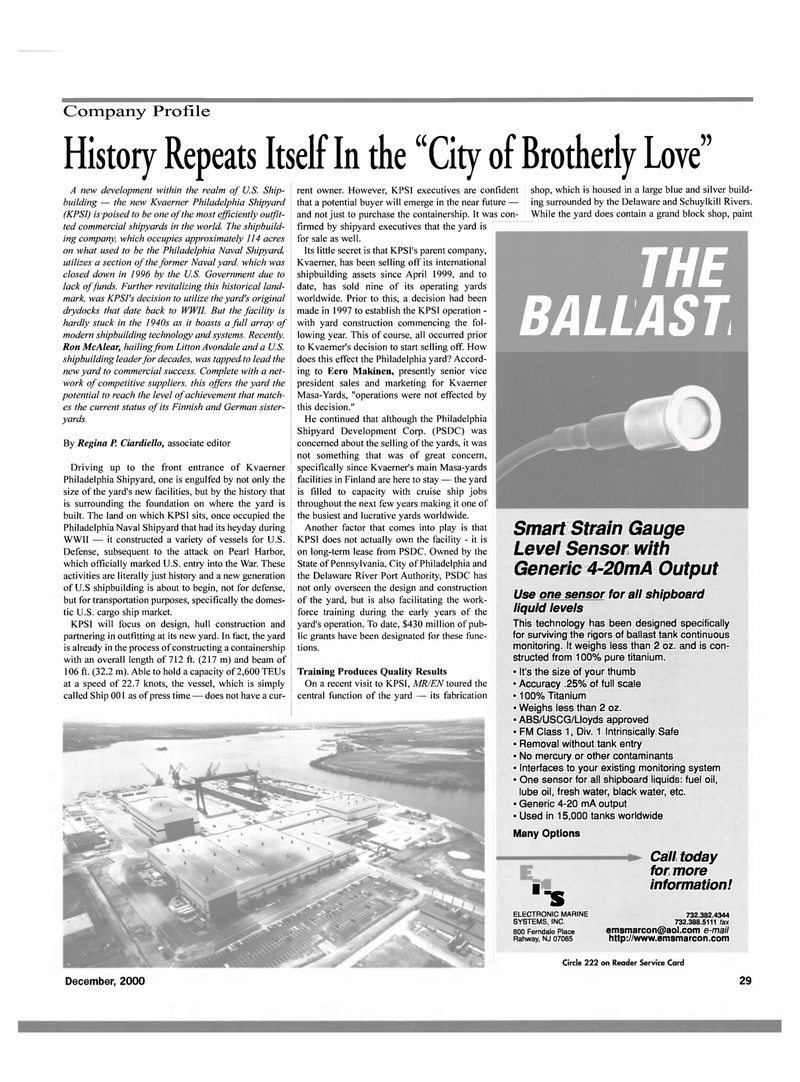
Page 32: of Maritime Reporter Magazine (December 2000)
Read this page in Pdf, Flash or Html5 edition of December 2000 Maritime Reporter Magazine
Company Profile
History Repeats Itself In the "City of Brotherly Love"
A new development within the realm of U.S. Ship- building — the new Kvaerner Philadelphia Shipyard (KPSI) is poised to be one of the most efficiently outfit- ted commercial shipyards in the world. The shipbuild- ing company, which occupies approximately 114 acres on what used to be the Philadelphia Naval Shipyard, utilizes a section of the former Naval yard, which was closed down in 1996 by the U.S. Government due to lack of funds. Further revitalizing this historical land- mark, was KPSI's decision to utilize the yard's original drydocks that date back to WWII. But the facility is hardly stuck in the 1940s as it boasts a full array of modern shipbuilding technology and systems. Recently.
Ron McAlear, hailing from Litton Avondale and a U.S. shipbuilding leader for decades, was tapped to lead the new yard to commercial success. Complete with a net- work of competitive suppliers, this offers the yard the potential to reach the level of achievement that match- es the current status of its Finnish and German sister- yards.
By Regina P. Ciardiello, associate editor
Driving up to the front entrance of Kvaerner
Philadelphia Shipyard, one is engulfed by not only the size of the yard's new facilities, but by the history that is surrounding the foundation on where the yard is built. The land on which KPSI sits, once occupied the
Philadelphia Naval Shipyard that had its heyday during
WWII — it constructed a variety of vessels for U.S.
Defense, subsequent to the attack on Pearl Harbor, which officially marked U.S. entry into the War. These activities are literally just history and a new generation of U.S shipbuilding is about to begin, not for defense, but for transportation purposes, specifically the domes- tic U.S. cargo ship market.
KPSI will focus on design, hull construction and partnering in outfitting at its new yard. In fact, the yard is already in the process of constructing a containership with an overall length of 712 ft. (217 m) and beam of 106 ft. (32.2 m). Able to hold a capacity of 2,600 TEUs at a speed of 22.7 knots, the vessel, which is simply called Ship 001 as of press time — does not have a cur- rent owner. However, KPSI executives are confident that a potential buyer will emerge in the near future — and not just to purchase the containership. It was con- firmed by shipyard executives that the yard is for sale as well.
Its little secret is that KPSI's parent company,
Kvaerner, has been selling off its international shipbuilding assets since April 1999, and to date, has sold nine of its operating yards worldwide. Prior to this, a decision had been made in 1997 to establish the KPSI operation - with yard construction commencing the fol- lowing year. This of course, all occurred prior to Kvaerner's decision to start selling off. How does this effect the Philadelphia yard? Accord- ing to Eero Makinen, presently senior vice president sales and marketing for Kvaerner
Masa-Yards, "operations were not effected by this decision."
He continued that although the Philadelphia
Shipyard Development Corp. (PSDC) was concerned about the selling of the yards, it was not something that was of great concern, specifically since Kvaerner's main Masa-yards facilities in Finland are here to stay — the yard is filled to capacity with cruise ship jobs throughout the next few years making it one of the busiest and lucrative yards worldwide.
Another factor that comes into play is that
KPSI does not actually own the facility - it is on long-term lease from PSDC. Owned by the
State of Pennsylvania, City of Philadelphia and the Delaware River Port Authority, PSDC has not only overseen the design and construction of the yard, but is also facilitating the work- force training during the early years of the yard's operation. To date, $430 million of pub- lic grants have been designated for these func- tions.
Training Produces Quality Results
On a recent visit to KPSI, MR/EN toured the central function of the yard — its fabrication shop, which is housed in a large blue and silver build- ing surrounded by the Delaware and Schuylkill Rivers.
While the yard does contain a grand block shop, paint
THE BALLAST
Smart Strain Gauge
Level Sensor with
Generic 4-20mA Output
Use one sensor for all shipboard liquid levels
This technology has been designed specifically for surviving the rigors of ballast tank continuous monitoring. It weighs less than 2 oz. and is con- structed from 100% pure titanium. • It's the size of your thumb • Accuracy .25% of full scale • 100% Titanium • Weighs less than 2 oz. • ABS/USCG/Uoyds approved • FM Class 1, Div. 1 Intrinsically Safe • Removal without tank entry • No mercury or other contaminants • Interfaces to your existing monitoring system • One sensor for all shipboard liquids: fuel oil, lube oil, fresh water, black water, etc. • Generic 4-20 mA output • Used in 15,000 tanks worldwide
Many Options "3
ELECTRONIC MARINE
SYSTEMS, INC. 800 Ferndale Place
Rahway, NJ 07065
Call today for more information! 732.382.4344 732.388.5111 fax [email protected] e-mail http://www.emsmarcon.com
Circle 222 on Reader Service Card
December, 2000 29

 31
31

 33
33
